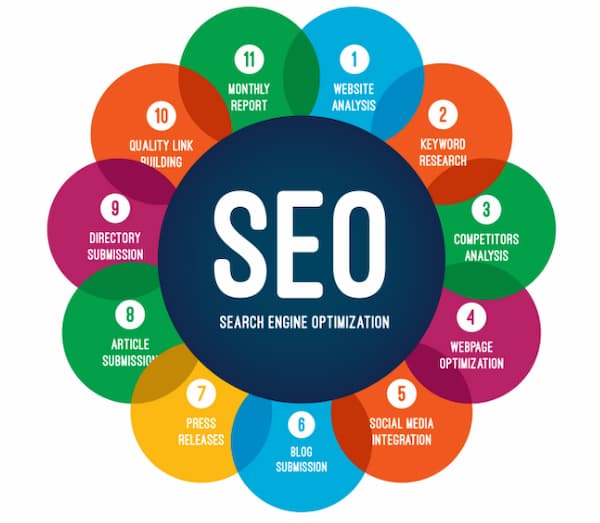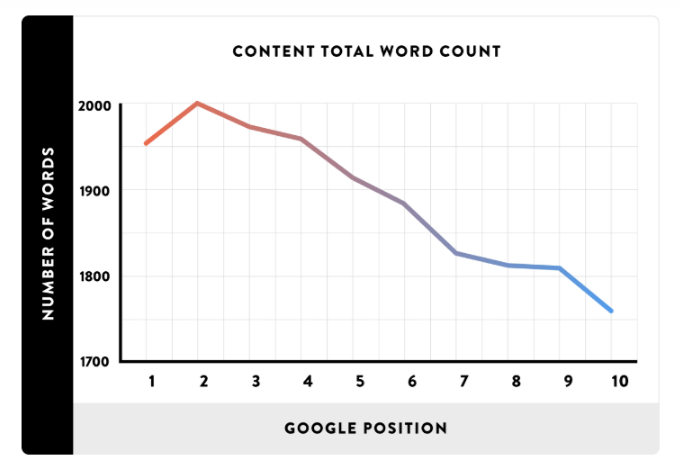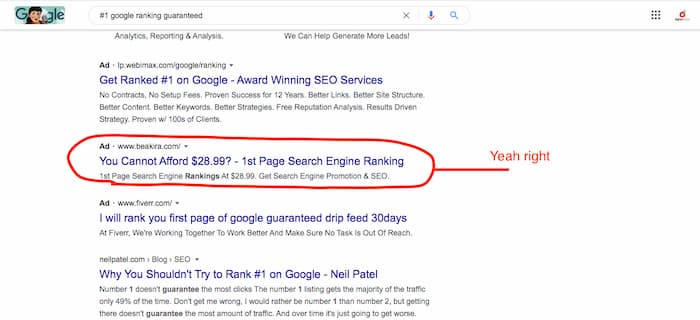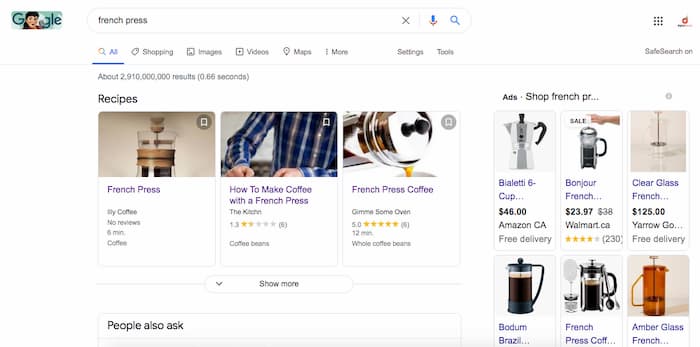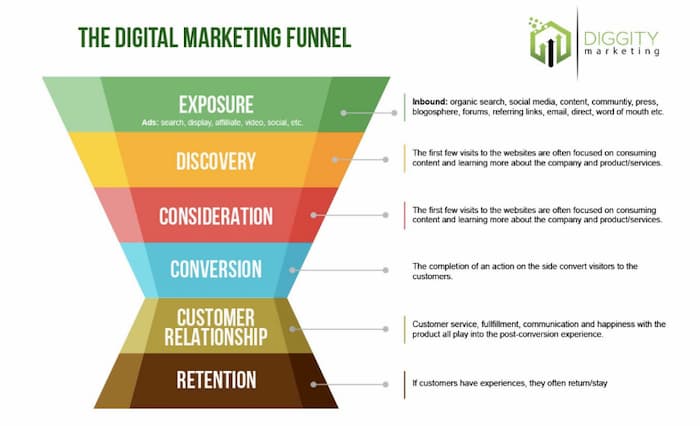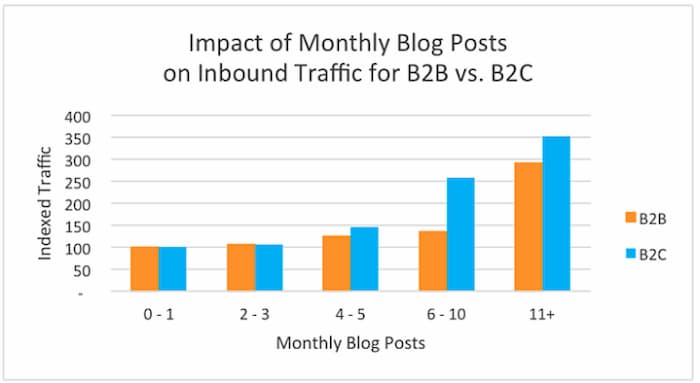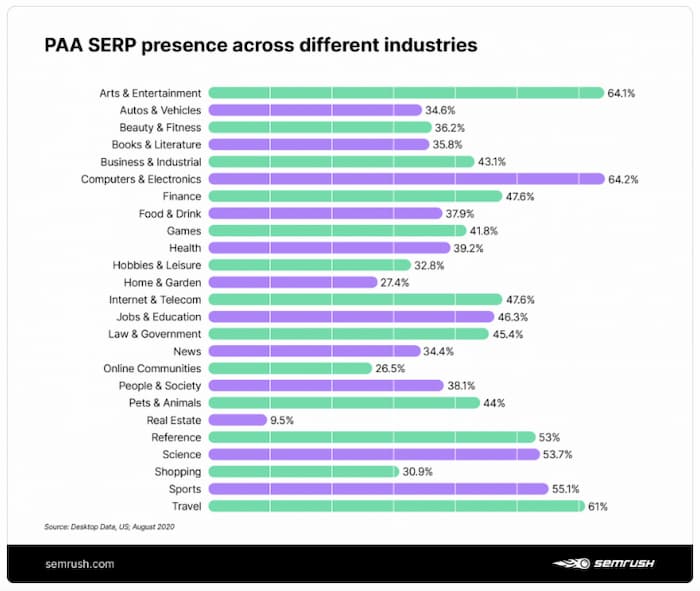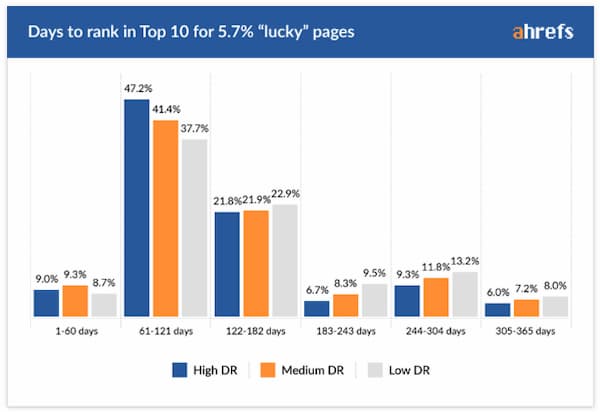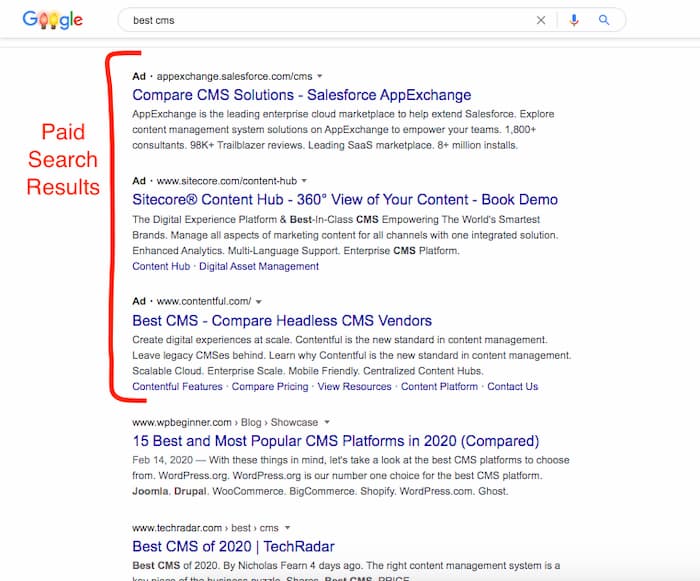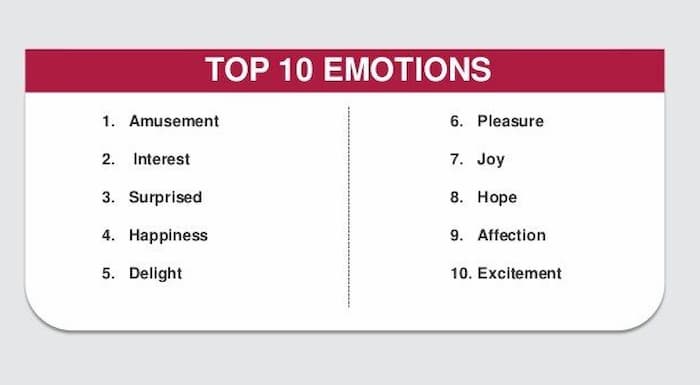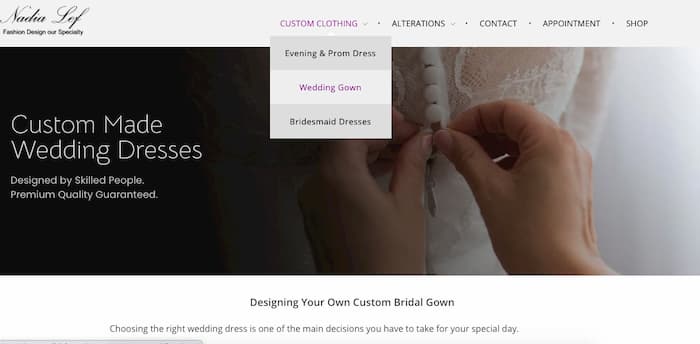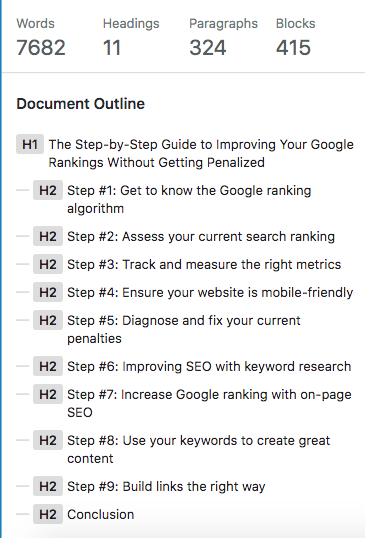14 SEO Myths To Eliminate For 2021
When you look at the bigger picture, the internet is still in its infancy. We’ve seen many drastic changes since Google emerged as the dominant search engine and they continue to make changes to its algorithm daily. Every so often algorithm changes can shake up the entire SEO industry. Constant turnover in what works and what doesn’t can give birth to SEO myths and cause them to circulate.
The truth is that Google’s algorithm is proprietary, making it impossible for anyone other than Google to know with 100% certainty how exactly it operates. Much of what we do know has come from large amounts of data and results in which we have drawn our own conclusions.
To this end, many people are still catching up with the times and are only now learning what search engine optimization entails. With so many years of changes, it makes sense that there are a lot of SEO myths circulating. This article will bust a few of these SEO myths so you can count on creating a reliable SEO strategy for 2021.
- Anyone can do SEO.
- SEO is primarily about keyword optimization.
- More links are better than more content.
- Longer content ranks higher.
- There’s a secret SEO recipe that ranks your website.
- SEO is a “one-time” operation.
- A guaranteed #1 position on the first page of Google.
- It’s better to hire an SEO company in your city.
- Cheap SEO services save you money.
- All backlinks are created equal.
- More website traffic means more revenue.
- You need exact match keywords to rank highly.
- Syndicate content gets you penalized.
- All SEO companies offer the same product.
#1-“Anyone can do SEO.”
The belief that anyone can do SEO is true in the sense that you could say “Anyone can be a doctor.” Sure, if you work hard, study hard and learn what you need to know, you can become anything you want to become. But if you think that an untrained and inexperienced individual is as capable as an SEO professional, this is a big fat SEO myth.
Anyone can learn SEO and at a basic level, understand the concepts and even apply the fundamentals of search engine optimization. Like any skill you practice, there is a learning curve to expect where you’re guaranteed to make mistakes and encounter situations that only experience and knowledge can solve.
Google recommends using SEO consultants
When you’re working on a website that earns you money, some things are best left to the professionals. Google itself recommends that every website owner at least consult with a professional.

There are mistakes that an inexperienced person can make that will cost your business more than it would to hire a professional in the first place.
For example, link building can be extremely dangerous if you’re not following Google’s best practices and guidelines. If you’re using the same words as anchor text to link to your pages, you may wind up beyond page 10 of the search results due to an algorithmic filter penalty.
Optimize your earning potential
Navigating around potential disasters is only one side of the equation. The other aspect of hiring an experienced SEO expert is that they know how to get the most out of your website. SEO is a continuous effort where making small adjustments for a few percentages more here and there add up to a lot of extra revenue.
For example, if you knew how to create a rich result you might be able to increase the click-through rate by a few percentage points. If your keyword gets thousands of searches a month, this translates into an enormous amount of additional revenue.
Luca Tagliaferro published his case study on the difference in click-through rate when adding a FAQ rich result to one of his pages. A small snippet resulted in 1.5 times as many clicks.
Hire specialists to get the best results
You wouldn’t ask your local butcher to get rid of a mole on your body just because he’s good with a cleaver.
You ask a specialist to remove it.
In the same way, you wouldn’t ask an IT guy (or web designer for that matter) to come up with an SEO strategy for your business. They may know a thing or two about SEO but when it comes down to getting the most out of SEO, it is a process best left to the professionals.
#2-“SEO is primarily about keyword optimization.”
This myth could also be phrased as “SEO is all about ranking” or “SEO is primarily about lead generation.” The truth is SEO encompasses a large segment of digital marketing. Most people don’t realize how far-reaching SEO is when it comes to anything search engines, making this statement a complete and utter SEO myth.
So what exactly is SEO? Search engine optimization is the process of making a web-property more likely to be displayed by a search engine for a specific search query. SEO is not just about ranking, lead generation, or keyword optimization.
It includes competitive analysis, technical improvements, conversion rate optimization, keyword research, link building, public relations, networking, revenue generation, content creation, on-site and off-site optimization and the list goes on.
SEO plays a role in almost every aspect of generating revenue from your website, social media, content marketing and/or paid advertising.
#3-“More links are better than more content.”
There was a time when the websites that had the most links ranked the highest on Google. Many SEOs reflect on this time as similar to the Wild West era when outlaws were able to get away with breaking the law.
In this period of time, software systems were developed to build thousands of links overnight which made it easy to game the system.
This method of ranking was eliminated by a series of updates (Penguin Update) and technological advances that allowed Google to assess the quality of backlinks.
The quantity of links is no longer the only variable in the ranking equation.
What is true is that the more quality links you have the more authority your pages gain.
The key phrase here is quality.
If there are any unnatural links or irrelevant links, they are ignored. If there is an excess of poor quality links, the authority and trustworthiness of your website is devalued.
This is reflected in your ranking and overall search visibility.
Content is still king
If your content is written for users and gets a good level of engagement, the backlinks will come naturally. If you campaign to acquire backlinks to good content, the process is much easier and faster.
It’s better to have more quality content on your site that users are reading through than it is to have backlinks to poorly written pages. At the end of the day, even if your pages manage to make it to the first page of Google because of your backlinks, it won’t stay there for long if your content doesn’t answer search intent.
#4-“Long-form content ranks higher than short-form content.”
One misconception in how to publish content that outperforms what’s ranking is to make it longer than the competing pages. The truth is that word count is not what makes a piece of content outperform another. In fact, word count isn’t a ranking factor at all.
Why would a search engine use word count as a metric?
— 🍌 John 🍌 (@JohnMu) August 31, 2020
What lends merit to this notion is that in creating a longer piece of content, you are forced to go deeper into detail or cover more topics within the page. Depending on your keyword, the more information you’re able to provide to your audience, the better you’re able to satisfy search intent.
The ability to satisfy search intent is what search engines will value the most when displaying search results. If the search query is an informational search that has multiple levels of depth to the answer, then creating a more detailed article will result in a higher ranking.
On the flip side of the coin, if the search query does not require depth to satisfy search intent, then creating a longer article would be an exercise in futility.
Why this myth is so confusing
The general trend that has become the norm is that content is becoming longer. The average first page search result is 1890 words.
There is evidence that Google values depth, but it must be taken in stride with what the intent of the user is when performing the query. It is not word count specifically that determines whether a page is better quality, but the ability to satisfy the users intent of the search.
#5-“There’s a secret recipe to rank a website.”
Many people have the belief that there is a secret sauce or some sort of magic bullet that will rank a website. SEO is quite the opposite in regards to transparency. There are no secrets when it comes to traffic generation or improving search visibility.
Transparency offers the best value
The best SEO consultants can break down an SEO strategy so that it makes sense to the client. The concept of search engine optimization in its simplest form is to create great content that users are searching for and make sure search engines can find that content for specific search terms.
The strategies and tactics that work for long-lasting results are not secrets. Anything that sounds like a magic bullet should be ignored since there is a shelf life for stuff like that-which usually falls into the realm of black hat SEO.
Practice white hat SEO
White hat SEO is the practice of adhering to Google’s best practices when developing a website. Link building is best done through any means that allows a webpage to accumulate natural and high-quality backlinks.
There’s no substitute for producing quality content and natural link building.
Anything else is short lived and could ruin the quality of your website.
#6-“SEO is a “one-time” operation.”
Many people are confused about the process of SEO and what it actually does over time. It’s common to hear someone ask to have their site optimized thinking it will be a one-time job.
This a complete SEO myth! The SEO process is multilayered and multidimensional.
On-page optimization is one of a few different aspects in developing a website’s content to drive traffic. There are four large groups you can label as part of the SEO process for developing content; keyword research, content creation on-page optimization and link building.
It took Ahrefs four years to build their blog to drive massive traffic. They were able to achieve such huge success in driving traffic by publishing top-notch, evergreen content and then ranking it to the top of the search results.
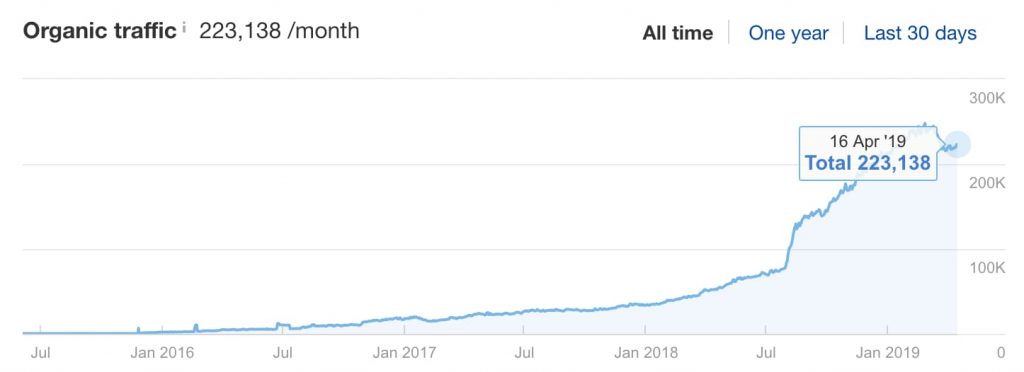
That doesn’t even touch on the technical side of SEO to produce and maintain a high functioning website.
And we haven’t mentioned the monitoring and tracking side of SEO that incrementally improves search visibility, quality of traffic and conversions.
SEO is far from a one and done operation and is nothing short of a long term investment.
#7-“A 100% guarantee to rank in the #1 position on Google.”
Let’s start by saying that unless you own Google, it’s impossible to guarantee the #1 position with 100% certainty. Search engines are changing all the time and no one but Google can account for changes in the algorithm that could result in the rise or fall of a website’s ranking.
Having said that, it’s possible to estimate rankings based on experience within the industry or experience in ranking the keyword itself. A 100% guarantee on a #1 ranking is impossible for anyone who doesn’t control Google, however, a seasoned professional could speculate ranking to a close degree of accuracy-especially if they’ve done it before.
FYI, it’s much easier to estimate entering the top ten results than to guess how long it will take to make your site first on Google.
#8-“It’s better to hire an SEO company in your city.”
The beauty of SEO is that it can be done from anywhere. Digital properties can be accessed and worked on from anywhere in the world. The location of your SEO Company does not matter if they are experienced and good at what they do.
Choose your SEO company for the right reasons
Choosing the right SEO company should be based on several factors such as experience, referrals, results and reputation. If you’re in Toronto and you had the choice of ABC SEO Company Toronto or. Rand Fishkin, The SEO wizard of Moz (he’s a big deal in SEO but based in Seattle if you didn’t know already), who would you choose?
Let me help you with this one-you choose the legend of SEO, Rand Fishkin. Why? Because Rand Fishkin will turn your website into a monster moneymaker. So what if you pay extra money every month. If you knew your earnings would increase by 30% at the end of the year wouldn’t it make sense to invest the money on a sure thing?
Let go of traditional ways of doing business
Location can be beneficial to some people for peace of mind. It’s nice to know you can run and bang on the door of a company if you need to go looking for them. At the end of the day, you should be deciding to hire an SEO company for the right reasons so you’ll never need to bang on their door.
Settle for zoom meetings if you’re the traditional type who likes to meet in person. If you want your business to grow, you also need to grow with the times. Your website lives in a virtual space so distance has no boundaries when it comes to choosing the right company for your business.
#9-“Cheap SEO services save you money.”
Finding the right people to work on your website for the right price is an important factor in making the best decision for your business. There’s no problem in choosing an SEO company that’s less expensive than another but it’s important to note that SEO services aren’t cheap. Choosing an SEO company because they’re offering cheap SEO services could cost you way more in the long run.
You get what you pay for. Be wary of cheap SEO services, as they do not include the same benefits of hiring an SEO company that does all the right things for your site. There are thousands of “SEO professionals” that will offer you prices that are too good to be true. Many of these services will submit your site to low-quality directories or link your site to their private blog network, both of which will ruin your website over time.
These companies can reduce your search visibility and cause more harm to your site than good. There’s no substitute for a professional, accurate website assessment and strategy session with an SEO specialist. Why leave the future of your business in the hands of someone who doesn’t have good references or a strong reputation for getting good results?
If you work with the right SEO company, you will make more money than you would without them. It’s the reason you hire a professional for these services. They make you more money through strategic planning and execution.
There are no shortcuts when it comes to SEO. Make sure your provider is up to par when it comes to putting in the work that will ultimately increase the revenue your website generates.
#10-“All backlinks are created equal.”
To the untrained eye this may seem like the case, however, it couldn’t be further from the truth. Some backlinks will help your website, some backlinks do not affect your website and backlinks that will harm your website. Knowing how to tell the difference can make a huge impact on the search visibility of your website.
For example, imagine you’ve started a small business that develops custom POS software for retail stores. Would you prefer a link to your website from Entrepreneur.com
or from bargainballoons.ca?
First off, Bargain Balloons (yes it’s a real site) isn’t even in your niche. It’s unrelated to your product and therefore a link from them will be ignored. In fact, if you continued to get links from websites like this, your website would start to lose search visibility. Google would downgrade the trustworthiness of your site and push it back in the search results.
A link from Entrepreneur.com however is an incredible link to acquire. Not only is this backlink from a website that specializes in entrepreneurial content, but the audience consists of the exact types of visitors you would want on your site.
A link from Entrepreneur would send other small business owners to your site that in many cases would be interested in your product.
This is the first huge win.
The second is the massive volumes of traffic the site generates. Your site would receive a substantial boost in referral traffic for the life of the article your link is on.
The last huge bonus is that Entrepreneur.com has massive domain authority. A link from them would transfer domain authority to your own site, giving you more ranking ability.
The following image is an visual example of Google’s PageRank theory. It shows how all websites are assigned their own values of PageRank, which Google uses in its ranking algorithm.
All links are definitely not created equal.
Consider the type of website the link is coming from
Another factor to consider is the different types of links that exist. First off, there are followed and nofollow backlinks. A followed link transfers domain authority, a nofollow link does not.
Besides this very important detail is also the issue of where the links are coming from.
A link from a directory will not carry the same weight as a link from another business within your industry. There is a value assigned to a link according to the relative ease in which it can be obtained. Anyone can get a link from a directory, but not everyone can get a business to agree to link to their website.
#11-“More website traffic means more revenue.”
Website traffic alone does not guarantee an increase in revenue. However, more targeted website traffic from high converting keywords will generate more revenue.
For example, imagine you sell men’s athletic wear on your website. If for some reason your website began ranking for the term menswear, it would have mixed results since this keyword has multiple possibilities of intent. Not all users that type this keyword will be looking for athletic clothing.
In fact, if we look at the SERP, it suggests this is a broad category. The first two results are local websites that list the top menswear stores (none of which are specifically athletic).
The majority of the results that appear for this keyword are higher quality casual and formal clothing.
Find the true intent of a keyword
Keyword research is one of the first components of SEO because it helps publishers understand whether the user’s intent for the search will result in a desired action on your website.
Some keywords represent mutliple intentions.
For example, the keyword French press could mean that a user wants to buy a French press, learn how to make coffee using a French press, learn what a french press is exactly and so on.
You can determine a great deal of search intent based on the search engine result page. The Google SERP features indicate intent.
A local pack would mean that people are looking to pick up a French press in their area.
If you see Google Ads appear, it’s an indication that people are making money on this search term because they’re paying to appear in the result.
Videos indicate there is a demand to learn more about a brand or how to do something.
Not all keywords result in an immediate conversion. 80% of keywords are considered to have informational intent. Not everyone who visits your website will buy something when they get there, however, they may become clients at a later date if you’ve established an effective marketing funnel.
When you can optimize your website for keywords that have a specific purpose in your marketing funnel, increasing traffic from those keywords generate more revenue.
Without testing, measuring and tracking your key performance indicators it’s difficult to know how well your website is performing in converting visitors into clients.
#12-“You need exact match keywords to rank highly.”
There is some truth in optimizing content with exact match keywords; however, it isn’t necessary to rank highly. Google ranks pages by keyword topic, not just whether a page has the keyword posted within its content, which makes this statement an SEO myth.
There are millions of examples where Google has ranked a page in the number one position without the page using an exact match keyword. This is because Google understands context and will rank pages according to how well they answer search intent.
Look at the top websites that rank for the term SEO content writing. Only one title in the top 4 results contain the exact match keyword.
If your target keyword is SEO content writing and your article is an ultimate guide on how to produce SEO content, it’s possible to rank for your target keyword because your page shares the same search intent.
Your title could be “How To Produce SEO Content: The Ultimate Guide.” If it’s the best piece of content and offer the most expert SEO writing tips, you’ll rank for the term.
Even if other sites have the exact match keyword within all of the expected places, your content will rank the highest of it is the best match to search intent and offers the highest quality of content.
Does adding an exact match keyword help with on-page optimization?
Yes, absolutely. In fact, it’s considered best practice to optimize your pages for a target keyword in which you would include that keyword in the places search engines use to categorize your content.
Including your exact keyword in the title, URL, image alt tags and within your content will contribute to a highly optimized page with more probability of ranking higher.
#13-“Syndicate content gets you penalized.”
There is a big difference between syndicate content and duplicate content, the latter being the one that gets you penalized. Syndicate content can actually benefit your site by amplifying good content. If the content you syndicate is being read by a lot of visitors on your site, it improves your user engagement metrics-which is a good thing for your ranking.
Take Medium for example. There’s so much content on this site that is directly imported from other websites. It still ranks for a lot of top keywords because it uses the correct method of assigning attribution.
Absolve yourself from all chances of a penalty by placing the correct canonical tags on the content you produce (WordPress does this automatically for you).
Credit the original website as the author for any content you syndicate. Use the `rel=”canonical”` attribute on the anchor tag that links back to the original article. This tells search engines you aren’t the original author, which means you’re not claiming the content as your own.
Where you get into trouble with duplicate content penalties is when you’ve copied another article and published it as your own. If the content is a match to another page-which would have been indexed before yours, your site will experience an algorithmic filter penalty.
Spun content is just as dangerous as duplicate content
The same algorithmic filter kicks in for spun content. If search engines detect that you’re spinning an article that already exists they will demote your page in terms of trust and authority. This is most obviously reflected in search visibility and ranking.
Always give credit where credit is due. If you’re posting someone else’s content, give them the link to attribute them as the original author and avoid the duplicate content penalty.
Your content will then be considered syndicate content, which is a perfectly acceptable practice when proper attribution is given.
#14-“All SEO companies offer the same product.”
Most SEO companies are capable of addressing the major aspects of search engine optimization, however, not all will offer you the same package. Some companies are better at certain things than others. Almost every company will promote the strategy that they’re good at because they know it will get you results.
This doesn’t automatically mean it’s the best strategy for your business. Make sure the company you choose offers a strategy that matches your business and industry. An SEO company might be absolute wizards in PPC campaigns.

That doesn’t mean it’s the best SEO strategy for your company website even if they get your business turning a profit. You may have bigger opportunities in developing your organic traffic.
It pays to interview three to five different SEO companies before deciding on who to work with.
You will do much better in the long run if you can find an SEO company whose strength lies in a process that is tailored to your operations and offer you the most long term growth.
SEO myths can make or break your strategy
The emergence of SEO myths is an inevitability that should be expected. No one knows what the Google algorithm is with 100% certainty. The truth is it continues to change on a daily basis.
Constant vigilance is required in order to stay on top of the SEO trends that are verified truths as well as the trends that become obsolete. Read industry websites and follow SEO influencers that report major changes to search.
ICYMI: Google is testing people also ask with question mark icons https://t.co/hBXjNAtkkX pic.twitter.com/OlOjspW8Lv
— Barry Schwartz (@rustybrick) December 30, 2020
Being an early adopter to new SEO trends can mean the difference in making thousands of dollars in revenue.
Identifying obsolete practices before you make the mistake of using them can save you an enormous amount of time and resources.
If you have any questions about the validity of an SEO myth that hasn’t been mentioned yet, feel free to contact us via email. We’re happy to share our thoughts.
7 Effective B2B Content Marketing Strategies In 2021
The world as we know it has changed drastically in the last year. There’s been a rise in demand for online services and products in many categories, while a waning demand in others has put more pressure on companies to perform. So where are we at when it comes to providing the most effective B2B content marketing strategies for our clients? Here are a few strategies you can be sure to see a lot of in the upcoming New Year.
Infographics
Visual content has made its mark in the content marketing world and none is so effective in a B2B setting as visualized data. Creating infographics will continue to be an effective B2B content marketing strategy long into the foreseeable future.
Direct marketing strategy
The ability to retain information jumps from 10% to 60% when presenting text with images as opposed to plain text. This makes visual content an obvious choice for companies who want their potential clients to remember important details in a pitch or project proposal.
Generate quality backlinks
Apart from the advantages of using infographics as marketing material, the fact that infographics produce 172% more backlinks than regular text articles makes them a major asset to a company. With more people searching online than ever before, there is more competition vying for important keywords that generate income.
Improved search visibility
Infographics contribute to a healthy backlink profile and can provide streams of traffic once they rank as resources for other amplifiers who publish content in your industry. Journalists, writers and other publishers in your niche will look for statistics, facts and resources to use within their articles. Infographics are an excellent way to provide a resource with visualized data, which is perfect for those in need of citing a resource.
An example of one is the infographic we did on Web Design Trends By Toronto Experts
Video marketing
The rise of video has been an obvious success story over the last three years. YouTube has posted some incredible statistics-more notably becoming the second most popular website in the world (overtaking Facebook). What once was a marketing aid for businesses has now become a full-on business model with engagement statistics through the roof.
Most notable is the B2C market since YouTube is often visited for product reviews and as a way for customers to learn about a product. However, many fail to see the power of video as an effective B2B content marketing strategy despite the overwhelming evidence of how it works to generate more revenue.
Here are five facts that provide evidence of the success B2B video content marketing has and will continue to have throughout 2021.
Expect to see more video infographics appear as companies make more of an effort to get more of their message across via this trending channel. There’s a fine line between maintaining a level of professionalism in terms of the video content you publish for B2B as opposed to B2C. A video infographic allows companies the benefits of the YouTube audience while maintaining a high level of professionalism.
Google feature optimization
The proof has already been laid out for us and as scary as it is, the truth is we are witnessing a decline in the number of clicks that are going to organic search.
As much as this may seem bleak and unpromising, there is a silver lining to this inevitability. Companies can optimize for Google features to counteract the trend of a declining organic click-through rate.
Featured snippets
The most obvious of all Google features is the featured snippet. This is one of the most valuable of all features because it takes the top position on the SERP. The featured snippet is considered position zero-the new first position because it absorbs the bulk of the clicks.
Optimizing for position zero is an effective B2B content marketing strategy because of the value it holds in traffic as well as branding. When your company is listed at the top of the results page as an enriched search result, it brands your company as an industry leader and an expert in its field.
Companies have and will continue to review first page positions they currently hold to optimize content to appear in this position. Winning the snippet can dramatically increase the search visibility of your website and contribute to more leads and revenue.
PAA boxes
The PAA box appears for a significant portion of search results. SEMRush has discovered that when you hold a position in the PAA box, you hold a position for many different variations of that question which can send a significant amount of traffic to your website. These multiple variations of questions that rank in the box are also known as content hubs.
The trend has been to optimize your content into as many snippets as possible. Post more content using tags highlights the information into recognizable chunks (or snippets) for search engines. This makes content more “snippable.”
What does “snippable” mean?
Snippable means to organize content to be recognized more easily by search engines. To make your content snippable leads to more featured results in PAA boxes, passages and featured snippets.
Google passages
If you haven’t noticed already, Google has begun to highlight the text on pages whenever you search for a specific answer to a question. This indicates the level of detail that you can expect in the upcoming era of search.
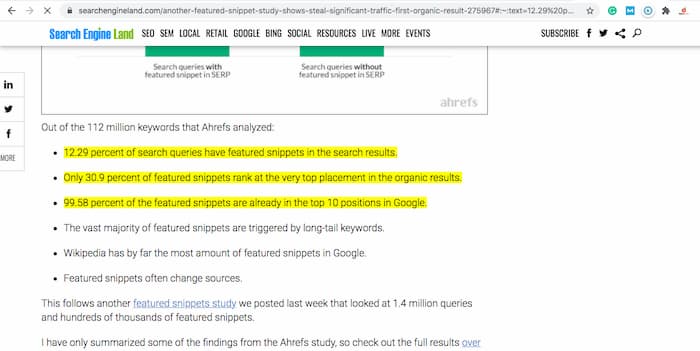
Not only do search engines find the pages with the most suitable content, but they highlight the text within the page that directly answers the question. Google passages provide us with all the more reason to make your content snippable.
Co-marketing projects and partnerships
Expect to see more companies partnering up as a B2B content marketing strategy for specific projects and/or promotions. The advantages of working with another company have a huge impact on expanding your audience and branding your company as an expert in your industry.
Direct marketing advantages
When companies form an alliance for a specific project, they are sharing one of their most valuable resources; their network. All promotions and content will go through the regular channels such as on-site content, off-site content, social media and any email promotional material.
More companies are creating more opportunities by leveraging their partners’ audience in exchange for their own. This symbiotic relationship can be an ideal partnership for those that aren’t direct competitors but share the same industry.
Airline, hotel and car rentals are an excellent example of how companies can team up and combine their efforts to give their customers the best prices.
Some companies aren’t anywhere close to sharing the same industry, yet cross promoting still positively affects their revenue. For example, Volvo became the official car for Legoland.
When you’re able to promote another company within your campaigns it paints a positive light on your brand. It shows you’re not afraid to help your audience find a quality product that you believe will help them in their everyday lives. This can contribute to more trust in your brand and ultimately more brand loyalty, sales and revenue.
Long term advantages
Another aspect to partnering with another company is the additional search visibility for the extended network. Keep in mind that backlinks are one of the largest ranking factors that affect search visibility. Working with another company’s network can result in a brand new audience that comes with more possibilities for link building and sharing.
The additional exposure to another network can give your company a huge advantage over your competitors. The surge in traffic can have a long lasting effect in your rankings from increased backlinks and search visibility.
Personalized email marketing
As one of the oldest, yet most effective forms of digital marketing, personalized email marketing will be a top choice as an effective B2B content marketing strategy.
A simple fact is that the ROI is unparalleled in the industry so it’s impossible to ignore (over 3800% ROI). The difference in creating campaigns that get the most conversions will be how well companies are able to segment lists and personalize content.
We’ve already entered an era where user engagement and personalization reign supreme. In order to make the most of what is already working to generate conversions, companies will need to continue to personalize content in order for it to reach its intended audience.
List automation is old news and in order to avoid the trash section of the inbox, personalized content is the only way to separate your company from the rest of the email campaigns.
On-site content development
The content you produce on-site is going to play a huge part on the search visibility of your website. The development of content that provides value to your audience is crucial for spreading awareness and nurturing leads that convert into sales.
Small businesses can expect to produce more leads regularly from publishing SEO content regularly. In fact, companies that publish 11 times a month get 3.5 times as many leads as companies that publish once or twice a month.
Information is in demand and the means for supplying the specifics to users searches has created benefits for being extremely detailed. The on-site content you produce will play a part in developing the success your website has in the search results and ultimately its performance as a lead generating asset.
Original data and research
Individual data from research, studies and surveys are among the most useful pieces of content you can develop for your company. Identifying what interests your clients is an effective way to publish content that your ideal audience wants to read about.
The more information you have about your clients, the better chances you have for engaging them on more levels. With the proper research, you can build your content strategy on topics that mean the most to your current and future customers.
Research, studies and surveys are excellent tools for developing more insight into what your clients want and how they experience they have using your products. Find out what works and what’s not to provide a better experience with your brand.
To generate original statistics on your findings gives you a foothold in the industry for publishing original data that no other company has access or has ever published. This is an excellent means for creating newsworthy coverage resulting in earned media and the potential of earning high quality backlinks.
Establish a B2B content marketing strategy for 2021
It’s cliche, and yet it remains one of the great truisms in digital marketing: Content IS King. What’s also true is “He who fails to plan, plans to fail.” The takeaway here is that by establishing an effective B2B content marketing strategy for 2021, you will be setting your company up for success.
Use any or all of the strategies above to drive robust traffic to your website and brand your business as industry leaders. The time has come where everything you do to improve your content will pay off in dividends further down the line.
Need help with your B2B content marketing strategy? Let us give you a hand by assessing your website and proposing a game plan to rank your website to the top of the search results.
Organic SEO Vs. PPC: Which Is Better?
It’s impossible to claim whether one form of traffic generation is better than the other. Like so many things in SEO, the truth is, it depends. To debate over organic SEO vs PPC and which is better, you’re going to need to consider a few important factors that go into making the decision on which avenue to pursue.
What is organic traffic generation?
The organic search results are the portion of the search engine result page that is generated based on the websites that have the best answer to a search query. This segment cannot be bought by anyone as the results are generated by the algorithm search engines use to display the best results to a search query.
For this reason, the organic results tend to instill the most confidence in users and attract the most clicks.
What is paid traffic (PPC campaigns) generation?
The top of Google’s search engine result page is typically reserved for 4 four paid results that are marked with the word “Ad” to indicate they are paid placements. Google Ads uses a Pay Per Click model that has been adopted by social media websites and of course, is used by the other search engines as well.
The concept requires you to pay for every click that a user makes to your website when you’re in a paid position on the SERP. This is your cost per click (CPC).
Advantages of organic search engine optimization
- More traffic
- Lower cost
- Continuous
- Adds value
Drive more traffic from organic search results
On average, the organic search results take up 40% of the click on mobile and 60% of the clicks on desktop. It is undoubtedly the largest source of traffic that is available.
People tend to avert advertisements, and will naturally skip over them and click on an organic result because it’s the most unbiased result. Of course, it depends on the type of keyword but for the most part, the organic results win the lion’s share of available clicks.
Lower cost alternative
Although there is still a cost to driving organic traffic, it becomes a fraction of the cost of what you would pay Google for the same traffic in the long run. This is because once you have a page that drives traffic, clicks to your site are free.
The major burden is the cost it takes to rank a page into the top 10 positions. With more traffic flowing abundantly to your website, your cost per acquisition lowers over time.
Provides continuous traffic
Organic traffic is continuous in regards to the fact that once you rank on the first page, you can stay there indefinitely. Even if another website happens to outperform your page, a drop in position does not stop the traffic to your website.
Holding a position on the SERP means driving organic even after you’ve stopped paying for SEO services, whereas with PPC your traffic stops when you stop paying.
Adds depth and value
Organic traffic generation involves publishing content that is being searched and found by users. As your site continues to target and rank for keywords that are important to your business, your website develops authority and depth. This never disappears.
Top keyword rankings for content that people are looking for is a valuable commodity. Your site becomes a resource the more SEO content that you publish for your audience. Therefore, the process for developing organic traffic raises the value of your website by adding depth to the niche-oriented content you publish.
Disadvantages of organic SEO
- Takes longer to generate traffic
- Mostly informational searches
Longer incubation time
There is typically an incubation period for being able to drive organic traffic with new content. The process for keyword research, content creation, optimization and link building can take months before a page begins to drive traffic from the organic results. In a study by Ahrefs of over 2 million websites, they found that the average time for a page to rank in the top 10 positions is over a year.
Only 5.8% of the websites they studied were able to rank on the first page in less than a year, and even so-they average over 2-6 months.
Bottom line is that driving traffic using organic SEO takes time.
Mostly informational searches
Since 80% of the searches made are informational, many of the keywords that are targeted to drive organic traffic typically attract visitors that are not yet ready to buy. This means there is more educating and nurturing the visitor before they can become a qualified lead and new client.
This means that there is more strategy involved for developing a marketing funnel and addressing the various stages of the buyer journey in order to convert visitors to clients.
When should you opt for organic traffic generation?
If you’re building an authority website, you’ll need to build your organic traffic. The content on your website will need to reflect what users are searching for and be the best solution to search intent.
If you’re a local business, you’ll want to build your organic traffic. Optimize to be found in local searches and the local finder.
When you’re invested in your business for the long run, organic traffic generation is the solution. As the highest source of targeted traffic, it will lead to the most revenue at the lowest cost.
Advantages of PPC
- Instant traffic
- Control over audience
- More insight into converting keywords
- Search visibility for competitive keywords
Receive instant traffic
Once you’ve created a PPC campaign you receive instant traffic. It’s not always going to make you money immediately as there is some time required to optimize your campaign. But as soon as you activate your campaign you will be getting clicks to your website from instant search visibility.
Control over your audience
You have the option to select the demographics of your ad campaign. You can literally choose who sees your ads by choosing preferred age, city, times, gender and a whole myriad of options to personalize the audience your ad appears in front of.
Insight into converting keywords
PPC campaigns are an excellent way to conclude what keywords are the best-converting terms for your business. You have access to the behavioural patterns of the users that click on your ad for every keyword within your campaign. This allows you to double down on the search terms that work and get rid of the keywords that don’t convert.
Search visibility on competitive terms
PPC allows your business a fair shot at appearing for search terms that would otherwise be difficult to rank for organically. When the first page of search results is littered with titans like eBay and Walmart, you can bid on those terms to get your product on the first page as well.
Disadvantages
- Higher CPA
- Traffic stops when you stop paying
- Less traffic
- No long term benefits
Higher cost per acquisition
One of the biggest downsides to PPC is it’s considerably more expensive than organic traffic generation. The average cost per acquisition will generally be the same throughout the life of your campaign as opposed to organic traffic which declines over time.
In fact, the CPA could rise should more competition for your keyword decide to join in bidding for the top position.
PPC is not a cheap solution and in many cases it takes money to make money. There is a learning curve to optimizing your campaigns to reduce the cost and increase the revenue you’re making.
Traffic stops when you stop paying
Unlike organic traffic generation, PPC is a pay to play type of format. You have to pay for your position on Google and when you stop paying, so does your lead generation, sales and new clients.
This presents a problem for businesses if the only way to generate leads is through paid traffic. If the price goes up in their niche, this could spell disaster for a company that solely relies on PPC for sales.
No long term benefits
Unlike SEO, PPC does not provide any long-term benefits to a website. With SEO, intrinsic value is constantly being added to the website through researched SEO content. Over time, a website can develop a strong reputation as an expert and authority within its niche.
PPC does not add value to content or alter your website in any way. It is simply a paid position in the search results to get visitors to your website.
When should you invest in pay per click (PPC)?
PPC is good for short-term or one time promotions. When you need traffic fast, PPC is the way to go. PPC can deliver you the traffic immediately from the audience you select.
This makes PPC a good option for companies that are just starting out and need new clients to get the ball rolling.
A new website will need time to develop content and strengthen their search visibility. PPC campaigns can supply the traffic required in the meantime to supplement the lack of search visibility.
Organic SEO used in conjunction with PPC
The best-case scenario is to use organic SEO in conjunction with targeted PPC campaigns. As an aggressive marketing strategy, the two working together should be synergistic in the sense that the data obtained from each PPC campaign can be fed into the SEO strategy.
Having more search visibility is never a bad thing. Even if you’re making less money on PPC than organic SEO, using the two together is simply working to increase your total revenue.
When to debate SEO vs. PPC
The choice between SEO and PPC is not one that you can make without exploring options, assessing your current website development in relation to the competitive landscape.
For example, if you’re in a local market or extremely small niche, you may be able to achieve search visibility with simple DIY SEO tactics within a short amount of time.
In a non-competitive environment, it would make more sense to focus your time and resources on developing your website with targeted SEO content.
However in a more competitive environment, having your website appear in the paid results as well as the organic results could be the right balance that pushes your website to new heights in search traffic and record-breaking revenue.
For more information on how to develop your online strategy, give us a call and we’ll give you our best advice on how to make your business more profitable.
7 Tactics To Improve Your Pay Per Click Marketing Strategy
If you’ve been paying attention to the profit Google has been turning over the years, you may have noticed a trend: They keep making more money. A large portion of the total revenue Google earns is from paid ads. Why not follow suit and make more money by incorporating better tactics to improve your pay per click marketing strategy?
Even though they can be much more expensive than organic traffic generation, businesses continue to invest in paid ads for one simple fact: They make money.
Whether you’re already running PPC campaigns, or you’re considering your first go at it, here are 7 tactics to improve your pay per click marketing strategy to increase the revenue you’re generating from each campaign.
Bid on your brand and the name of popular competing brands
If you break down the intent of a brand search, it’s highly transactional. When someone is searching for a specific brand, they already have a product in mind and are in the buying frame of mind. Bidding on popular brands can put your website in front of a large group of searchers with buyer intent.
The larger brands have caught on to this pay per click marketing strategy and will protect the hijacking of their brand by bidding on their brand name. Search for any large corporate brand and you’ll see their Google Ad taking up the first spot in the search result.
Although this tactic is one of many pay per click strategies that are somewhat well known among the larger brands you can still find loads of opportunities where popular SMBs have failed to capitalize on this knowledge.
Bid on popular competing brands to capitalize on an audience with buyer intent. Don’t forget to bid on your brand and protect the name of your company from being used as a way your competition makes money.
Put 80% of your effort into the headline
The 80/20 rules apply here where your headline counts as the most important part of your advertisement. People are going to click on the headline that captures their attention with the most enticing and relevant message. Use headline tips and strategies to ensure your ad receives a high click-through rate to maximize its potential.
Here are a few to get you started:
Use a number in your headline
The use of a number can attract more attention and interest in your content. People like to know what they’re getting and the use of a number manages expectations-which appeals to most people.
Using an odd number can increase your CTR by up to 20%
Spark emotion within your headline
There have been thousands of tests and studies on the effectiveness of ads and the bottom line to remember is that if your ad can evoke emotion it becomes much more powerful.
Here is a list of the top emotions that seem to have a positive effect on the way people respond to ads:
The most successful ads that go viral seem to be those that target humour and are amusing to people. They get shared and spark interest.
Snickers, launched their campaign “You’re not you when you’re hungry” and targeted misspelled words. In just two days they reported over 550k impressions with a CTR of just over 1%. The result was over 5000 people landing on their mini-website in just 48 hours.
The type of emotion you evoke depends on the niche that you’re trying to promote. If you’re advertising for a funeral home, there’s going to be a big difference in your tone than if you were promoting a kid’s event space.
Knowing your audience is a crucial aspect in determining the emotion of your target. Keep in mind that people respond with much more energy when you’ve triggered an emotional response.
Dynamic keyword insertion
Google, Yahoo and Microsoft offer this advanced feature to allow your ads more flexibility by inserting related keywords depending on the search.

For example, if you sell tennis equipment, you may have an advertisement for tennis racquets. You can initialize dynamic keyword insertion by inserting the code:
{KeyWord: Tennis Racquets}
This will then tell the search engine to insert the most appropriate keywords in your ad according to what the user is searching.
If a user searches “kids tennis racquets” or “adult tennis racquets” or “club level tennis racquets” those keywords will be inserted into your ad to make it more relevant to the searcher.
If there are no relatable substitutes, your ad will be displayed with your primary keyword, which in this case would be tennis racquets.
Dynamic insertion contributes to higher click-through rates by creating more relevance to the user’s search.
Use retargeting pixels
Retargeting is one of the best ways to reduce your cost per click because of its success in increasing conversions. This tactic is highly effective in promoting a higher conversion rate because your ad will reappear in front of users that have shown interest by clicking on your ad and landing on your website.
The retail industry, on average, requires 6-8 touchpoints before making a sale. When you have an ad following a user for an additional 8-12 times it gives your brand more exposure and more opportunities to remind the user about your product or service.
How does it work?
You need to install a pixel on your website that you receive from your ad campaign. Whenever a user lands on your site, a cookie is uploaded into their browser. That cookie reactivates the ad within the display network for however many times you choose to set it for in your campaign.
Use a landing page to personalize your campaign
Always use a landing page to personalize your PPC campaign to increase conversions and address a specific need that your ad is promoting.
Many businesses make the mistake of sending a user to their homepage from an ad and leave it to the visitor to find what they need. Rather than take the risk they don’t find what they need, send them directly to the page that has exactly what they need.

Always eliminate clicks and unnecessary obstacles that get in the way of a visitor finding what they want and purchasing it. Navigation to your product should already be done for the user so there’s nothing left to chance.
A landing page gives you a way to warm your visitor up with information about your product and guide them to a purchase decision.
Provide social proof in your copy
We live in a time where reviews count for a huge part of the decision making process for many different industries. People will read the reviews on Yelp before picking a new place to eat dinner. There’s value in having social evidence of the value your business represents.
Include social proof in your copy to promote more clicks to your site. People will be more inclined to trust a company that can show how many clients they’ve already helped solve problems with their product.
Having 5-star reviews with customers raving about how good your food is will bring in more eager customers who want to see what other people are talking about.
Use Google’s Smart Bidding system
You can automate your bidding strategy by using Google’s Smart Bidding system to increase conversions, ROAS and reduce CPA. The system is a combination of AI and machine learning that is effective at predicting trends and tendencies of users to increase the likelihood of making a conversion.

Use Smart bidding to get the best times to bid, the amount to bid and other areas that are automated based on machine learning. Automating the way you run your PPC campaigns with Smart Bidding leads to conversion rate optimization as well as reducing the cost per acquisition over time.
Google suggests running a Smart Bidding strategy for at least 30 conversions or one month to get the full benefits of machine learning applied to your campaign.
Incorporate PPC Strategies to Increase Conversions
There are many pros and cons to using a PPC campaign within your digital marketing strategy, but the bottom line is that they make money. There’s no substitute for getting your brand at the top of the page for important keywords.
If you compare organic traffic generation to pay per click campaigns, organic has more potential with less cost in the long run. However, using a combination of both can make your digital marketing campaign even more profitable.
Incorporate proven tactics to improve your pay per click marketing strategy to increase conversions, lower costs and boost your revenue for every campaign you run.
Want to hear more about how we can help your business generate more revenue? Give us a call and let us give you a breakdown of the opportunities available to your website.
6 Tips To Increase Conversion Rates On Your Website
It’s one thing to get visitors to your site but what’s the point of driving traffic if the visitors don’t end up buying a product or subscribing to your mailing list? The goal of driving high volumes of traffic to your website is to increase the revenue your website generates. This article will give you a few tips on how to increase conversion rates, which leads to new clients, subscribers and ultimately more sales.
What are conversion rates?
A conversion rate is the percentage of visitors that perform a desired action on your website. The action can be whatever you decide is the ultimate goal for your traffic. For instance, if you were selling products a conversion would be when a visitor purchases one of your products.
If 1000 visitors visit your website and 50 visitors make a purchase, your conversion rate is 5%.
50/1000=0.05
Conversions don’t necessarily need to be a purchase. You could also set up conversion goals of acquiring contact information.
If a visitor subscribes to your mailing list this can also be considered a conversion.
If your website is set up for AdSense, a conversion would be for a visitor to click on one of the ads on your pages. This would be the most desirable result when you’re getting paid for every click someone makes on advertisement on your website.

You can set up multiple conversion goals for your visitors as well as track the results using Google Analytics.
Once you have your conversion goals in place, you can see where your pages succeed in guiding visitors to making the most conversions.
Use the following tips to increase conversions rates on your website.
Use an effective call to action
Never assume that your visitors know exactly what to do on your website. Make it very clear for users what the next steps are to move forward in making a conversion.
For example, if you’re in the service industry let them know how they can get personalized help using your services by clicking the button to call your business at the end of every article.
Gently urge your users to complete the desired action. If you want people to like or share your article on social media, you need to ask them to do so at the end in a clear and polite way.
If you want your visitors to sign up for your email list, there needs to be a call to action to guide them into doing so. If the only text your opt-in box has is “Name” and “email address” why would anyone enter their information?
There has to be a message that urges visitors to fill out your form. Using an effective call to action is an absolute necessity to increase conversion rates on your website.
Internal linking strategy
The internal linking strategy implemented on your website can directly affect your conversion rate. Internal links are a great way to guide visitors through related content within your site. Not only can you get more content in front of your audience, but you can guide them to the pages that convert at the highest rate.
You should already be tracking the conversion rates of your pages on Google Analytics or your analytic tracking software of your choice.
Identify the pages that are converting at the highest rates. You can do this by going to behaviour, Site content, All pages.
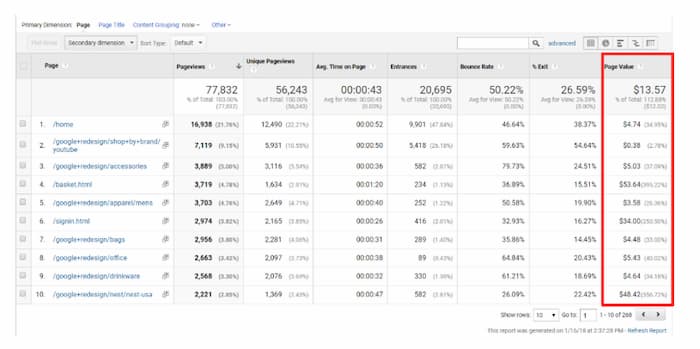
Filter the pages to list the page value starting at the largest amount to the lowest.
Make it a priority to link to these pages whenever possible. Guide users to these pages by using editorial links to hint at the pages they may be interested in.
You can also give users the option at the end of an article to visit the pages that they would also be interested in reading.
The more opportunities you give visitors to get to the pages that convert at high rates, the higher you’ll increase conversion rates will be from your total volume of traffic.
Page load time
The time it takes your pages to load has a direct impact on your bounce rate. It’s been proven that visitors will back off of your page at an alarmingly high rate when your page speed begins to exceed 3 seconds of load time.
By increasing your page speed, you can retain a large percentage of the visitors that land on your website. The lower your bounce rate, the more visitors will have a chance to go through your content.
This ultimately leads to increase conversion rates when a larger percentage of your total volume of traffic is actually getting to the pages you want them to see. Reducing the number of people you lose to slow load time increases the conversion rates.
Email reminders for abandoned carts
Did you know you can increase your conversion rate by up to 69% by sending up to 3 email reminders to those who have abandoned their carts?!
Imagine, a user finds your site, they read your content, they research options and they choose your product, and are filling out the purchase information and they suddenly get called to work or dinner or their kid pukes all over their office.
These are users who have already decided to purchase your product but life just got in the way for whatever reason.
Email reminders are the best way to keep your company in mind and get them back to your site to finish checking out. This strategy is definitely one to incorporate in your email marketing.
Send email reminders on a set schedule for anyone who leaves a cart abandoned to get them back on track to finishing the check out process.
Make things happen ASAP (as simple as possible)
In order to increase conversions make the process as easy as possible by eliminating the number of things a user must do to complete a conversion. Reducing the number of obstacles that stand in the way of completing a goal will increase conversions to your site.
Leadpages found that by making a single field for an email address rather than a field for name plus email address, increased conversions by 12.44%. The concept is simple enough to understand; People are less likely to fill out long forms than they are to fill out short ones.
The less effort it is for someone to give you their contact info, the easier it is to entice them to fill out the form.
Amazon realized this and had massive success with their one-click ordering system. When you can order a product with minimal steps, there are more people that will make it through the conversion process.
Although it may be easier for companies to have a user’s information on file for repeat orders and even a history of products purchased, the option to purchase as a guest will increase the number of conversions made by new clients.
Allowing users to avoid a lengthy account set up before buying a product speeds the process up which means less chances of interrupting the conversion process.
Make your conversion process as simple as possible to see more goals completed on-site.
Use split testing to identify preferences
It’s hard to know exactly what the majority of your users prefer without split testing the options you have available. Simple things on your site such as colours, headlines and placement of features can increase conversion rates on your website.
Leadpages found that when they changed the colour of their button from orange to green that conversion rates went up 86.41%.
Split testing can uncover certain patterns or tendencies of your users that result in more desired actions on your website.
Use split tests for everything you can get your hands on. Test headlines for your landing pages to see whether the users that end up clicking are more likely to convert.
Test the placement of buttons, the background colour of optin forms, the images on optim forms the text that you use as a call to action. Literally everything that can be interchangeable in design has the potential of increasing your conversion rates.
Improve conversion rates for increased revenue
Increase the revenue your website generates by improving the way it influences users to perform your desired action.
In an increasingly competitive search environment, improving conversion rates is an effective way to continually improve the efficiency of your website. Increasing your conversion rates are a way to make more money from your website without the wait time for content to rank for a keyword.
Follow these tips for better conversion rates from your website for increased revenue from new clients.
Don’t have time to do it yourself? Click here to speak with an SEO consultant to learn more about how we generate more revenue for our clients.
How To Create A Marketing Funnel For An Ecommerce Website
There are always exceptions to the rule but for the most part, it takes more than one visit to a website before a visitor makes a purchase. Learn how to create a marketing funnel for an e-commerce website to drive more targeted traffic and convert more visitors into repeat customers.
The sales cycle that your typical customer experiences from start to finish can be categorized into four distinct stages; awareness, consideration, decision and advocacy.
Consider the possibility that every visitor to your website is at a different stage in the cycle and it only makes sense to publish SEO content that accounts for the various stages within the sales cycle.
What is a marketing funnel?
The marketing funnel refers to content that can meet a potential buyer where they are in their understanding and move them closer to making a purchase. The marketing funnel addresses a series of stages that a buyer experiences which is commonly referred to as the buyer journey.
The content at each level of the funnel caters to the visitors on your site by meeting them at whatever stage of the journey they’re in with the goal of moving them deeper into your funnel.
Imagine a doctor approaching a man with testicular cancer and going to straight to the point about the need for surgery. No explanations, just“This is what has to be done….”
It’s needless to say that the need for testicular surgery would not be well received by any man who doesn’t understand what’s happening.
There needs to be a sit down about cancer, what it is, how it works and what will happen without surgery and of course, how the surgery will solve the problem.
Similarly, there are multiple stages a person goes through before making a purchase that is represented by a marketing funnel.
To get a visitor to the point they’re ready to buy, there needs to be a basic level of understanding of what they’re buying and why your company is a good choice. The concept of the buyer journey is used to gauge how well your content meets your visitors at the different levels of their understanding.
Creating content for every possible stage allows you to move visitors along the funnel, to become closer to making a purchase and become loyal brand advocates.
Awareness stage
At this stage, the buyer isn’t aware of the specifics of the problem they have. They know they have an issue they need to be resolved but they’re not sure about what it is and how to resolve it.
An example of this could be extremely dry skin. A person may have psoriasis or eczema, but may not have ever heard of either. If your website sold skincare products to combat eczema or psoriasis, creating content that describes the symptoms would be considered content at the awareness level.
Here’s an article from the Huffington post that ranks for dry skin on elbows. There’s no doubt that the companies in this article needed to pay for placement in return for the thousands of clicks to their website.
Content at the awareness level educates your audience about the basic details of their problem and how your product is used to overcome it. At the awareness level, your content would be optimized for symptoms that your product solves like dry skin for a skincare company.
The volume of searches for keywords at the awareness level is the highest of all stages in the buyer journey. These types of keywords are considered top-of-the-funnel keywords that build awareness of your product and brand but aren’t typically “high converting” search terms. The more people you can reach with your content, the more potential clients you drive to your website.
Consideration stage
At this phase of the buyer journey, visitors are aware of their problem and may also be aware of how to fix it, however, they are not ready to buy. At this stage, they are still in research mode and will be looking to compare options to find the best possible solution at the best price.
At the consideration stage, you would publish content that shows your visitors why your product is effective and superior to other options. This moves buyers forward to the final stage in the funnel by convincing them that you’re trustworthy enough to make a purchase.
Content at the consideration stage includes case studies, visual content, comparative analysis, original research and statistics, etc.
Content that arms your audience with the information needed to make an educated purchase decision builds trust in your brand. Rather than being too “salesy” or “pushy” about how great your product is, it’s considered best practice to create content that educates and demonstrates your expertise in your field.
Case studies
There’s nothing more convincing than a real live case study of the success you’ve had with existing clients. This type of content allows visitors to relate to someone with similar problems and see how your company resolved those issues with your business solutions.
Case studies can also be a form of storytelling, which is a powerful method of branding. People tend to remember stories more than statistics and numbers. Create relatable stories infused with real statistics and results to instill confidence and trust in purchasing with your company.
Original research
This is one of the best forms of advertising when it comes to creating an online presence and moving visitors deeper into your marketing funnel. Original research in your industry sets your company apart from the masses. It gives you the edge for creating new content with statistics and facts that no other company can compete with since they’re statistics that are generated from your research.
A lot of good things happen when you’re able to use original research to your advantage. The first is that original statistics attract backlinks. When you have statistics that no other company has, writers and publishers, tend to link to the source of that stats-and that happens to be your website. This pushes your website up in rank and authority.
In addition to being cited as a resource by those in your industry, you also are eligible for what is called earned media. That is, giving journalists and reporters something to write about that gets your company into some of the bigger publications and ultimately in front of thousands of readers.
Earned media is a powerful way to create brand awareness and assert your company as an authority and industry leader.
Decision stage
The decision stage is where your buyer is ready to make a purchase. They have established what they need and who the top choices are and need only the final push to make the purchase. Publishing content at this stage involves offering discounts, coupons and promotions to entice your visitors to make a decision.
Your product pages and services pages are where the conversions from visitors to clients are made. It’s necessary to have a page that inspires confidence in your product or service and that’s easy to navigate, making the purchase as easy as possible.
Loyalty and advocacy stage
This stage of the buyer journey can be the most valuable to your business. Consider the amount of time and resources to educate, convince and convert just one new client. Who better to market to than existing clients who have already purchased with you?! These are your most valuable assets to your business.
If they’ve already purchased with your company, there’s a very good chance they will purchase from you again since you’ve already gained their trust.
Apart from future sales, you want to keep your clients extremely happy, so that they’re able to turn around and tell other people how great your company is. Referrals are the highest form of marketing, and what better way to grow than to have happy clients tell other people how you’ve helped them.
Content at the advocacy stage includes sending coupons, VIP promotions, personalized offers and anything that expresses your gratitude for their loyalty.
Increase the lifetime buyer value for each of your clients by giving them the best customer service possible. The more you give, the more you get back.
Conversion rate optimization
To get the most out of your product and service pages, you need to measure and track the behaviour of your visitors to see what they do on your page. If there are specific patterns that are leading your visitor exit without converting, you will need to change those aspects of your page that are influencing that action.
Improving the conversion rate on your pages can be done using many different tools, however, Google Analytics can provide the user engagement statistics you need to improve the conversions on your page.
Track metrics such as bounce rate, time spent on pages, average pages per session, exit page and the user flow to determine the weaker points of your website and where you can improve.
Bounce rate
The bounce rate is the total number of users that back out of a page without interacting with anything else. This statistic can be useful for determining whether the content on your page is a match to intent, whether the content is engaging or whether you have a technical deficiency that’s causing visitors to leave.
For example, if your page speed is too slow to hold the attention of users, this results in high bounce rates. Lightning-quick pages that load under 2 seconds keep more visitors on your page and lead to higher user engagement.
Keep in mind that the bounce rate can be misleading if users are going to a page and getting exactly what they need from your website. For instance, if people are going to your site to get the address or phone number, they may bounce right off as soon as they get what they need.
Identify the cause of a high bounce rate to determine whether you need to improve the quality of your page. In many cases, improving the bounce rate will lead to more time spent on your site, higher click-through rates, more user engagement and ultimately higher conversion rates.
The improvement in user engagement statistics is considered positive ranking signals-especially on the first page of results, which can lead to higher SERP positions.
Click-through rates
The click-through rate is an important metric to analyze in your content at the awareness and consideration stages of the buyer journey. You want to make sure you’re moving people along the marketing funnel and that they are engaging in your content by clicking through to related articles.
If users are not clicking further through your website, it’s important to understand what they’re doing and what your content is lacking to create low CTRs.
Adding internal links to related content is the simplest solution to moving users along to more pages within your website.
A more difficult task is to re-evaluate the content that visitors are bouncing from to improve the copy, change the topic or remove the page altogether if it’s not able to achieve its purpose.
Time spent on-site
The average time spent on a website is an indication of how many visitors are interacting with your content. People must be getting through the content you’ve published to know whether they’re reading it through or bailing on it after a few paragraphs.
If there’s a 3000-word article that people are landing on, and they’re leaving after 45 seconds-it’s an indication that this piece of content is not doing its job. It would take at least 5 minutes to get through long-form content so look closer at where the disconnect is between you’re your content and your audience.
If people are not spending enough time, adding videos, images or more multimedia are alternative options to increase dwell time.
Conversion rates
To track goals, you need to set them up in Google Analytics. Every page on your site should have the desired action you want your visitors to take. Create goals on your website to effectively track where you’re losing visitors and where you’re succeeding in moving them along the buyer’s journey.
Create conversion goals at the awareness and consideration stages
If you’re creating content at the awareness level, the goal is to click through the links on your page that take them through to content at the next stages. Create tracking links that indicate whether the visitors clicked on the internal links you’ve provided.
If you’re not getting the click you can test whether it’s the content, by providing different options or if it’s the placement, by presenting the option to click on internal pages a different way.
Conversion goals at this stage of the marketing funnel will help to identify the content that people are most engaged in. This can serve as a way to build more content around the successful topic ideas that are getting the most clicks.
Conversions at the decision stage
Improving your conversions at the decision stage has a direct impact on your revenue. Make sure you’re taking advantage of all the potential ways to track what your visitors are doing on your page.
There are heat maps and split testing software that can help with the details.
With heat maps, you can see how far down the user scrolled on your pages as well as what buttons were clicked the most.
Split testing software can help you get into the finer details of things like the colour of your buttons. For example, choosing different colours of buttons can lead to small increases in conversion rates.
Track every option that’s available to track within your content to create the most understanding of what your visitors are doing and most importantly, what they like and don’t like. The data you generate gives you the means to improve the user experience your website offers and positively influence the actions visitors take on your website.
Map out the sales funnel to your e-commerce website
One of the most important aspects of developing your website is planning the site structure ahead of time and documenting how you intend to drive traffic. This means incorporating SEO at the earliest stages of your website’s development.
Whether you’re just starting or your website has been up for years, go through your content starting at the conversion pages first. Work your way up by layering your content from the bottom of the marketing funnel to the top. This strategy provides a way to convert the traffic you’re already getting and slowly increase the volume as you go.
Establish a basic marketing funnel and track your results. As your website continues to generate data, you’ll be able to make the changes necessary to constantly improve your traffic and conversions which leads to more sales, revenue and a long list of happy clients.
DIgital Ducats Inc. specializes in optimizing websites for increased conversions and sales. Learn more about our custom-fit SEO services and how we can optimize your website to generate more revenue for your business.
SEO in 2021: Changes Are Coming…
Although many of the main ranking factors will remain important, the industry forecast suggests we should expect a few important changes to SEO in 2021. There’s not a lot that you haven’t heard before, but change takes time and in 2021 there are a few changes that will officially have landed and will change the way we optimize websites. This article will give you insight into what changes to expect with SEO in 2021.
Core Web Vitals
It should come as no surprise that Google is moving towards more accurate ways of measuring user experience and user engagement. One of the key metrics that are going to play a big part in this movement is Google’s Core Web Vitals.
Core Web Vitals were added to Google Search Console in May 2020 as a way to give publishers more insight into what pages need attention. Core Web Vitals gives you the means for identifying:
1) Largest Contentful Paint
2) First input delay
3) Cumulatie Layour Shift
It’s every search engine’s mission to display websites that provide the best solutions to search intent as well as the best experience for users. A big part of the user experience is the time in which it takes a page to load. Search console provides users with the necessary information and alerts to maintain the speed performance of your website.
Although you may have a fantastic score for desktop page speed,

Pay attention to the mobile version of your page speed since this is the version that Google indexes first.

Don’t be alarmed if your score seems atrociously low. It can be common for a lot of websites that have long-form content with a lot of images. The point is 2021 will require you to continuously work towards increasing your site speed. It should be a regular part of your maintenance routine.
Keep in mind that just because your site loads faster than anyone else’s, won’t mean you’re going to rank in the number one position. The popular opinion is that Google won’t be rewarding the fastest pages as much as penalizing extremely slow pages.
Click here for tips on how to improve your page speed.
Ranking passages
Google has already begun to rank passages, that is, a few sentences from articles that directly answer a search query. You may have already seen a bit of this happening when you click on a featured snippet that takes you to the page with the answer highlighted in yellow.

This is a pretty big deal because it means that you can drive more traffic without being ranked on the first page.
The way to optimize for passages is to make sure your content is sectioned off in distinct segments. Use the appropriate h-tags to create subtitles that clearly indicate what your content is about. This makes it easier for search engines to find and categorize the information on your website.
This doesn’t change the way Google will be ranking pages-that will remain the same, however, this is a new addition to the way search engines will be displaying search results that should be taken into consideration when writing SEO content.
Establishing domain authority
If you thought link building was hard already-well, it’s getting harder! Domain authority is becoming a more difficult task to improve without getting links from the experts within your field. Google wants to display websites that can be relied on for quality information.
This will put a bigger emphasis on earned media, visual content and original research. This is the kind of content that will put your website on the map and land you some high-authority links.
Expertise Authority and Trust
If you’re website states facts that are incorrect according to an authority site in your industry, your credibility is shot and Google will choose to display another site over yours.
What will move the needle the most for young developing websites is to acquire links from the biggest site in their niche. You need links from the experts to validate your expertise. When you can get links from the authority sites within your niche, you become an authority in your own rights.
E.A.T. has already become a major aspect of the YMYL industries. Any type of medical publication needs to be written by a doctor or professional in the field. For it to rank, that professional should have the proper credentials to validate their work as well.
As we venture forth further into 2021, we’re going to see more of the EAT principle in effect.
The second wave of featured snippets
The featured snippet is increasingly appearing in search results. It’s becoming apparent that it absorbs a significant number of clicks for a search and is a valuable position to add for branding. Good SEO in 2021 will involve going after more featured snippets for increased search visibility.
To maximize the possibility to appear in a featured snippet, you need to make your content “snippable.” For example, publish definitions and keep your answers between 40-60 words. Paragraph snippets are the most popular form of snippet-which accounts for roughly 80% of all featured snippets.
Remember you need to rank on the first page of search results to be eligible to win a feature. Work on creating more opportunities for traffic through feature snippet campaigns.
Local SEO
Local SEO has always been important but because of the global pandemic, it will pay off double time to maintain a local SEO strategy. Keep publishing local content and feed your Google My Business profile content to maximize the search visibility of your website in your city/area.
People are going out less and purchasing from businesses that are close to home. Make sure your GMB profile is up to date in every aspect and you’re actively engaged in adding local content to your site and profile as well as answering questions that may appear on your profile.
CTR is increasingly becoming more important
The organic click-through rate is steadily dwindling due to Google SERP features absorbing all of the clicks.
In 2021 it will be increasingly important to improve the click-through rate of your pages directly on the SERP to maximize the traffic a first page appearance drives.
Structured data markup is one of the additions you can make to your pages to encourage rich results. Make your search listing more attractive in the search results to attract more attention and take up more space in the SERP.
The FAQ rich result is a perfect example of a rich result that demands more attention from the larger area the search listing takes up.

Additionally you can improve things like your headlines and meta descriptions. If there are older pages that are currently ranking, sometimes an update can make the difference in attracting more visitors to your page.
Search intent shifts and what you thought might be enticing a year ago, maybe a little out-dated and can use a facelift to drum up more clicks.
Search intent
It will be necessary to become a search intent ninja in 2021 to make sure your keywords and content are a perfect match to what users expect to see. Search engines are becoming more and more accurate at identifying exactly what users want when they type in a search and if you’re going against the grain your pages will be left in the dust.
Make sure you’re doing your homework when you’re establishing the true intent of a keyword. The more accurate you are in pinpointing intent, the more likely you are to rank in a top position.
Prepare for a new era of search engine optimization
Although claiming “a new era” is a little melodramatic, next year will bring about a few different changes in the way we optimize websites. Search engines are always updating and adjusting to make things a little easier for users. Change isn’t always bad and like every new update, we experience new opportunities lie ahead.
Ask us about custom search engine optimization services to find out how what we can do for your business.
How To Find the True Search Intent Of A Keyword
SEOs talk a lot about search intent as a major factor for achieving search visibility. The significance of search intent is that search engines want users to be able to find what they’re looking for with the least amount of effort. If you know what a user is looking for, you can publish the content that can be displayed as the best result to a search query. This article outlines how to find the true search intent of a keyword to drive more targeted traffic from higher-ranking positions on the SERP.
This function of SEO is critical because if you miss the mark identifying the intent, no matter how good your content is, no matter how many backlinks your page has, you will NEVER maintain a position on the first page of Google. This makes identifying and satisfying search intent a fundamental aspect of developing keyword and content strategies.
Basic forms of intent
At the highest level, you can break down search intent into three major areas; informational, navigational and transactional. Each of these categories represents a basic motivation for initiating a search.
Informational
As it turns out, informational searches account for about 80% of the total searches made on search engines. Providing useful information on your website can accelerate the growth of traffic being driven to the top level of your marketing funnel.

By making visitors more aware of their problems and the solutions that you offer, you brand your company as an expert in your niche. Publishing SEO content regularly facilitates your ability to reach a larger group of people searching for information about the problems your product or service solves.
Navigational searches
These types of searches are when users already know what they’re looking for and are looking for a way to get there. There are millions of searches for the term “Facebook login” every single day made by people who want to get to Facebook.
Although navigational searches can drum up a significant number of searches, they are typically not keywords you would use in your SEO strategy.
Transactional searches
Users who want to make a purchase will use transactional keywords that represent buyer intent. Transactional searches represent users searching for a way to buy a product that they have already researched and are ready to purchase.
One way to research transactional keywords is to use Google Keyword Planner. Here you can find the level of competition, the average price paid for a click from that keyword (cost per click or CPC) and the approximate volume of the keyword being searched.
Determine general intent with a SERP Analysis
The first step to identifying search intent is to analyze the first page of search results. You can tell a lot from the features that a search engine displays in response to a query.
For example, if you were to search the keyword microwave oven you would find a slightly mixed bag of results. Users who search this term could be at the buying stage or they could be in the research stage.
The first three results are category pages for big-box stores selling microwaves.

Further down we have a local pack for people who want to visit a store that carries microwaves.

Lastly, we have a section Google titles “Research microwave oven” and displays articles that compare brands and models.

If we were to change the search to Walmart microwave oven, we immediately see the intent of the search switch to mainly transactional. Evidence of this is the Google Ads that immediately pop up above the fold.

The organic results are primarily Walmart pages because this is a branded search. It’s clear that the user is in the purchase stage and is ready to buy a microwave, making this a transactional search.
If we type in the keyword best microwave, you can once again see how the intent shifts to an informational search. The articles displayed on the top 10 are all targeting the consideration stage of the marketing funnel.
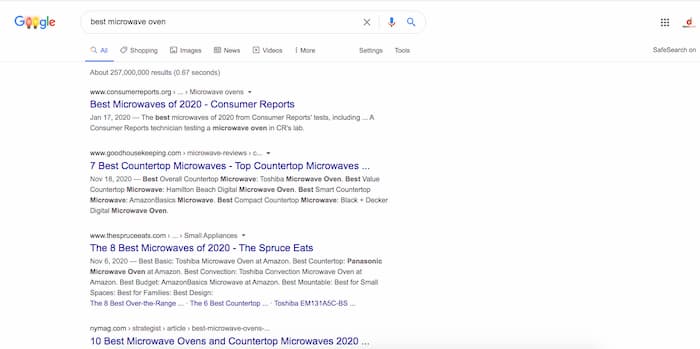
This is an informational search because users want to research and compare options. Evidence of this is in the fact that the search results are mainly blog posts that compare different microwaves.
The lack of Google Ads is also another indication that the main intent of the user is to gather information and they’re not quite ready to buy yet.
Identify the content type that ranks best
To rank highly for informational search terms, you have to pinpoint the underlying motivation of the user and address their intent better than any other page. The titles of the top 10 organic results are a good indication of the type of content that has the best chances of ranking.
The term best microwaves clue us in to the fact that the user is looking for a) a buyer’s guide on how to choose the best microwave or b) The best features that microwaves offer. Every search listing in the top ten for this term is either a listicle (numbered list of “X of the best microwaves” or a buyers guide.
To publish content that has the best chance at ranking, you would publish an article written in this form.
Account for complete topic coverage
To publish a page that outperforms the competition you need to be able to provide the user with what they need to end their search. The proof is in the pudding and by going through the top three results, you can get an idea of the level of depth and topic coverage required to satisfy the intent.

If you scan through Consumer Reports, the number one search result, they’ve grouped microwaves into two major categories; countertop and over the range.
They compare five microwaves in each category and provide links to buy the microwaves from multiple vendors.
To compete with this page in terms of content, your page would need to cover each of those aspects and provide some sort of value-added aspect.
An example could be by adding more detailed images, a video that summarizes the content or more products in your comparison.
Create audience-centric content
Search engine optimization is constantly including more ways to measure audience-centric content. User engagement statistics enable search engines to gauge how well a piece of content can hold the attention of visitors and ultimately satisfy the underlying intent of a search.
Identify search intent during part of the keyword research process to optimize to be found by the most accurate audience. Understanding what a user is looking for enables you to publish content that hits the mark and ranks highly in the search results.
Anything less and you can be sure any first page appearances will be short-lived. Content that nails intent creates long-term value and high search visibility that drive streams of highly targeted traffic.
Domain Authority & What It Means For Your Website
You may have heard the phrase domain authority being passed around quite a bit and it’s probably for good reason. Many SEOs use the term to describe the likeliness of a website to rank since it refers to the aggregate link equity a domain possesses.
The truth is that domain authority or DA is a term and value that has been formulated and branded by Moz. Other companies have their own versions of how they measure it but the entire concept is a proprietary metric Google used in its algorithm called PageRank.
What is PageRank?
To be honest, no one knows for sure what exactly went into the PageRank calculation, but what we do know is that it had a lot to do with external backlinks. Google used to disclose the PageRank of every page on the internet. This way you would know how powerful a page was and whether it had a strong ability to rank.
PageRank is based on one of Google’s earliest patents. It states that the popularity of a site could be measured by how many websites linked to it. This is baked into the Google ranking algorithm and remains true today since backlinks are among the top three ranking factors.
The more backlinks a website possesses from relevant websites, the more ranking power it gains. This flow of “link juice” is commonly referred to as “authority.” When a website accumulates thousands of links from related websites, its authority grows.
In 2016, Google stopped publicly displaying PageRank because it contributed to rank manipulation. People would focus on PageRank rather than relevance when linking to other websites in an attempt to boost the ranking ability of their page.
When PageRank stopped being published, a few companies developed their own system for assigning a similar value to web pages. Moz was among the first to come up with DA or domain authority, which measured the aggregate link equity of a domain.
Page authority vs. domain authority
Page authority represents the aggregate link equity of a specific page. Google doesn’t rank domains in the search results it ranks pages. This makes PA or page authority a more accurate measure of the ranking ability of a specific page.
The content on a page is what counts as being relevant to a search. This means that even if your domain authority is considerably lower than another website, you can compete with their pages if you have enough support from other websites linking to your page to bridge the gap in authority-assuming your content is a better solution to search intent.
Advantage of high DA
Keep in mind that a high authority domain has a head start on low authority domains when they publish a new page.
For example, a website with a DA of 80 can publish a brand new blog post whose page authority automatically starts at 45 DA.
Whereas when a website with a DA of 33 publishes a new blog post the new page will start with a DA of 18.
Therefore it will take more backlinks for the lower DA website to even out the page authority when competing for the same keyword in the search results.
The importance of domain authority
The truth is that the higher the authority, the easier it is to rank. It’s easy to get hung up on page authority and domain authority because there’s a specific value to compete with, however, it’s not the only thing that will rank a web page.
Google has actually stated that domain authority doesn’t exist.
we don't really have "overall domain authority". A text link with anchor text is better though
— Gary 鯨理/경리 Illyes (so official, trust me) (@methode) October 27, 2016
Here’s a video of John Mueller actually stating they don’t use overall website authority scoring.
That may be true for them but for SEOs and businessmen, it helps to know what you’re up against when you’re considering keywords to target. If you see 8 out of 10 websites on the first page with a DA over 80, you know you’re in for a long battle to get anywhere near the first page.
Domain authority places your domain in a general category that’s comparable to other websites. It gives you an idea of how close the website is in terms of credibility and authority.
DA in link building
Link building is not an easy task these days, so having a high domain authority is a big advantage to ranking in the search results. Linking from high DA websites is a big advantage because they drive your DA up higher.
PA in link building
Page authority is more accurate in measuring link authority when it comes to ranking for keywords. It gives pages a chance to compete with high DA websites. When there is good content on a page that serves the intent of the search and other websites are linking to it like crazy, it’s going to move up in the search results.
This doesn’t necessarily mean that it’s only because of the links and actual value of PA. It’s a combination of the fact that people are linking to the content because it’s obviously worth linking to in the first place.
There are plenty of instances where low DA sites rank on the same page as high DA websites. It just depends on the content, the optimiztion and how many links the lower DA site has to compete with the higher authority websites.
Here’s an example of a website with a low DA and NO links ranking on the first page with high DA websites:
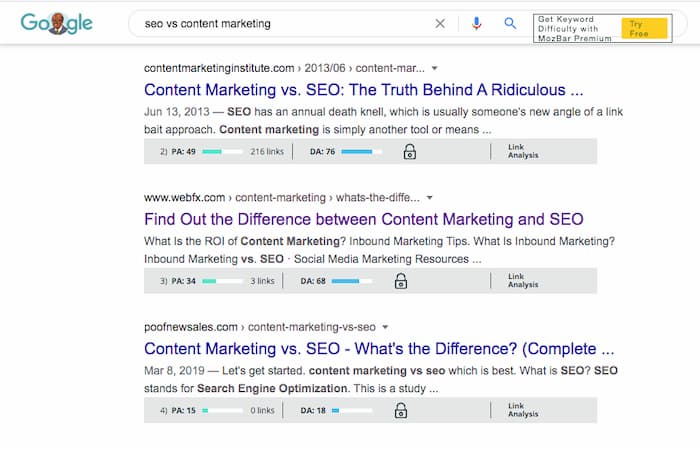
Other measures of DA
Moz was not the only company to come up with a measurement for authority. There are several companies that use a similar system to measure the quality and quantity of backlinks that a page and domain possess.
Here are a few:
Ahrefs: DR and UR (domain rating and URL rating)
Majestic: TF and CF (Trust flow and Citation Flow )
SEMRush: Authority score
Conclusion
In an effort to gauge the competition, many companies have come up with their own systems for measuring overall authority. Although it does not represent the actual value of PageRank, they are a measure of the aggregate link equity that each page or domain possesses.
Domain authority is not an exact measurement for determining rank, but a tool that is commonly used to gauge the level of difficulty in acquiring a similar number of backlinks to compete and outperform competing pages.
The takeaway here is that although it’s an important ranking factor, it not the measurement of DA that matters most since it’s a combination of ranking factors that make up a ranking. Use DA as a general guide for determining the strength of competition and as a way to look deeper into what makes a page rank highly.
The Difference Between SEO and Content Marketing
There are a number of different strategies within the digital marketing spectrum. Most of which are their own unique and distinct entities that can easily be differentiated between one another. SEO and content marketing are unique in that sense.
A PPC campaign is different from a website design. Social media marketing is completely different from email marketing. When it comes to SEO and content marketing, however, the lines are more blurred because they work together pefectly.
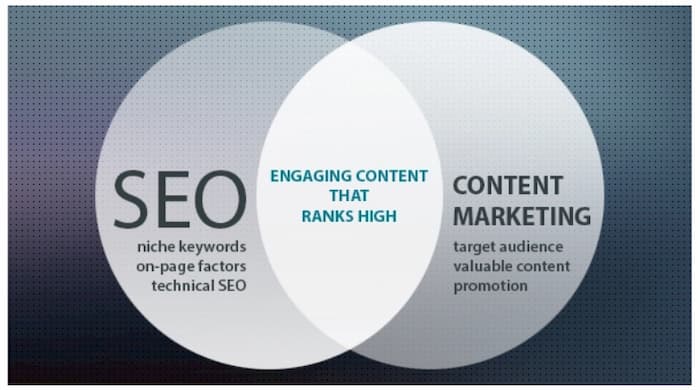
People get confused about the two strategies since quite a large part of each strategy overlaps with the other. This article should straighten out any misconceptions you may have about the two and give you a better understanding of how they are used together to maximize results.
What is SEO?
Search engine optimization services incorporate a variety of tactics to improve the likelihood of content being found by users and search engines. SEO uses keyword research, keyword targeting, keyword mapping, on-page optimization, off-page optimization, content creation and technical SEO elements to improve the overall optimization of a page or piece of content.
SEO has a narrow focus
SEO has a more specific focus because it is primarily keyword-based. It’s true; search engines have evolved from ranking web pages solely by keywords, however, keyword targeting is necessary to make sure your page gets in front of the right audience. The result is that an optimized page will not only rank for one keyword, but a series of keyword variations as well.
Search engine optimization is an analytical process for not only identifying the audience, but for finding out what they type to search for topics and what is required to appear at the top of the search results.
SEO is technical
SEO involves incremental changes and additions that continuously move your page closer to the top of the searches. SEO goes beyond the content to improve on technical aspects of performance that search engines credit as positive ranking signals.
Technical issues that affect indexing are a major component to SEO. Improving page speed is also a factor that affects the ranking and engagement statistics of a web page. Maintaining longer dwell times, higher click-through rates and increasing the average number of pages per session are all calculated efforts to improve the quality of content on a website.
So how does this tie in to content marketing? First let’s define what content marketing means to a business.
What is content marketing?
Content marketing means identifying an audience and creating content to educate and/or entertain based on their interests. Content is typically created for a broader audience that appeals to all stages of the buyer journey.
Content marketing can be for social media, increasing conversions on a website or creating awareness by appearing on popular websites. Content marketing can come in the form of research, storytelling, articles, images, videos, slide shows and literally any form of multimedia.
What’s the difference between SEO and content marketing?
The difference between SEO and content marketing lies in the scope of which each has in terms of an audience. SEO has a narrower focus that is keyword based. SEO focuses on the intent of the audience and identifies the technical requirements to reach that audience.
Content marketing has a broad focus that can apply to an audience with multiple intents. There are no technical requirements to create the content necessary to serve its purpose.
How content marketing and SEO overlap
Combining SEO and content marketing is where we see powerful results.
First of all, SEO can’t exist without content.
SEO optimizes content to be found by a specific group of searchers. Without any content to optimize, there is no SEO.
Content marketing becomes a powerful method of marketing when it’s optimized to appear in front of a specific audience. By identifying what people are looking for in searches, you can create content that satisfies their intent.
Good content brings brand recognition, brand loyalty and more confidence in making a purchase from your company.
By identifying the major keywords being used to search for your products and the problems and solutions related to using your product or service you can reach a specific group that is more likely to convert from visitors to new clients.
SEO establishes the parameters for what content is needed to generate more traffic to your website. Content marketing supplies those requirements.
Create content that’s in high demand
At the end of the day, you want to create content that people are actively looking for on Google. The process that’s proven to be the most effective for driving targeted traffic is simple:
- Establish the true intent of keywords that represent high business value.
- Create content that satisfies the intent of the search.
- Optimize content to appear for your keyword topic.
- Improve ranking and increase traffic to your pages by building links and promoting on social media and other content distribution channels.
This four-step process works to create new streams of high converting traffic. This system requires targeted SEO content writing with consistent production to create long-lasting results in the search engines. The result is increased revenue from more traffic and new clients.
Speak to a professional today and learn how to drive traffic with an SEO content strategy custom-fit to your website. For more details visit our SEO services page.


